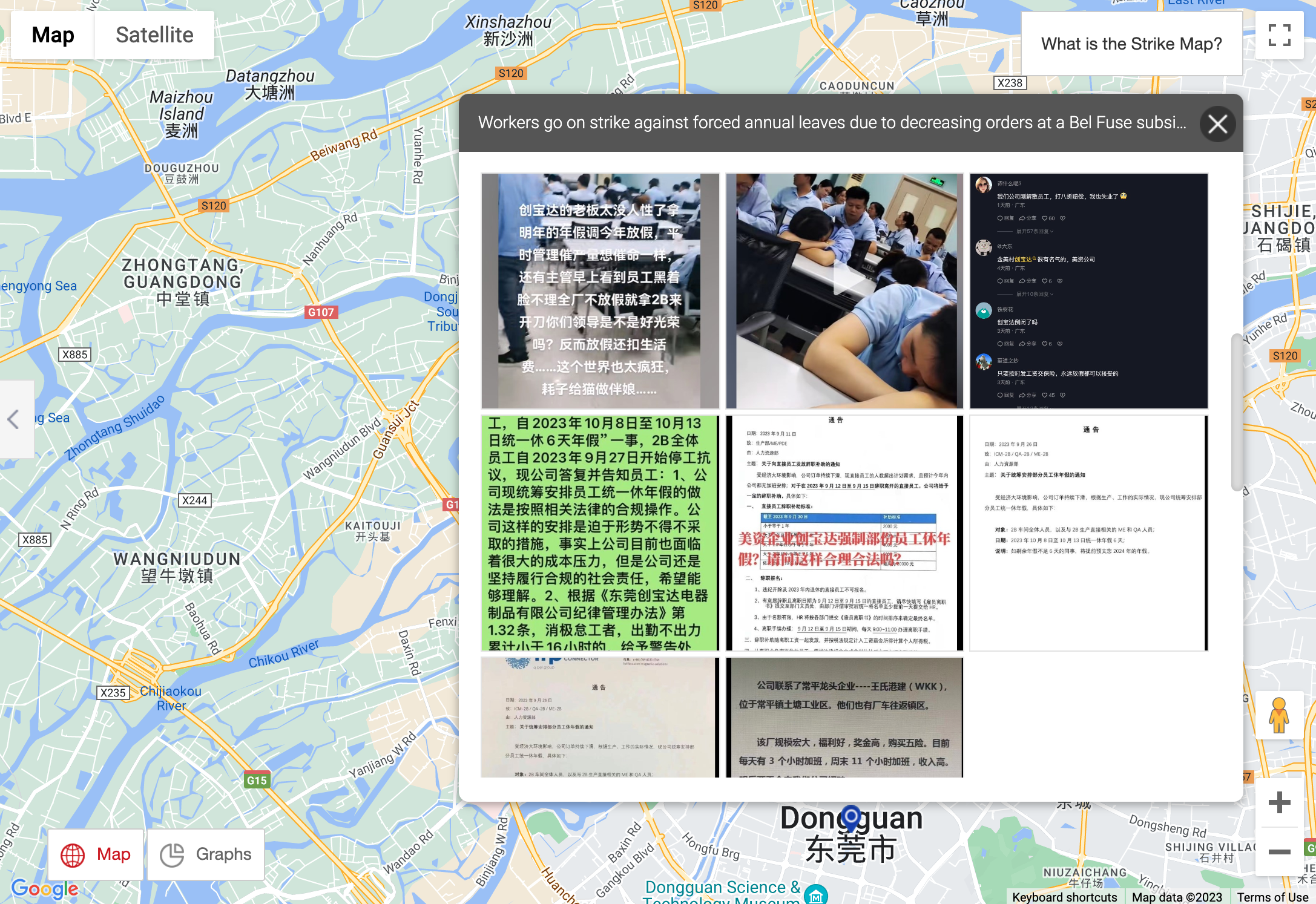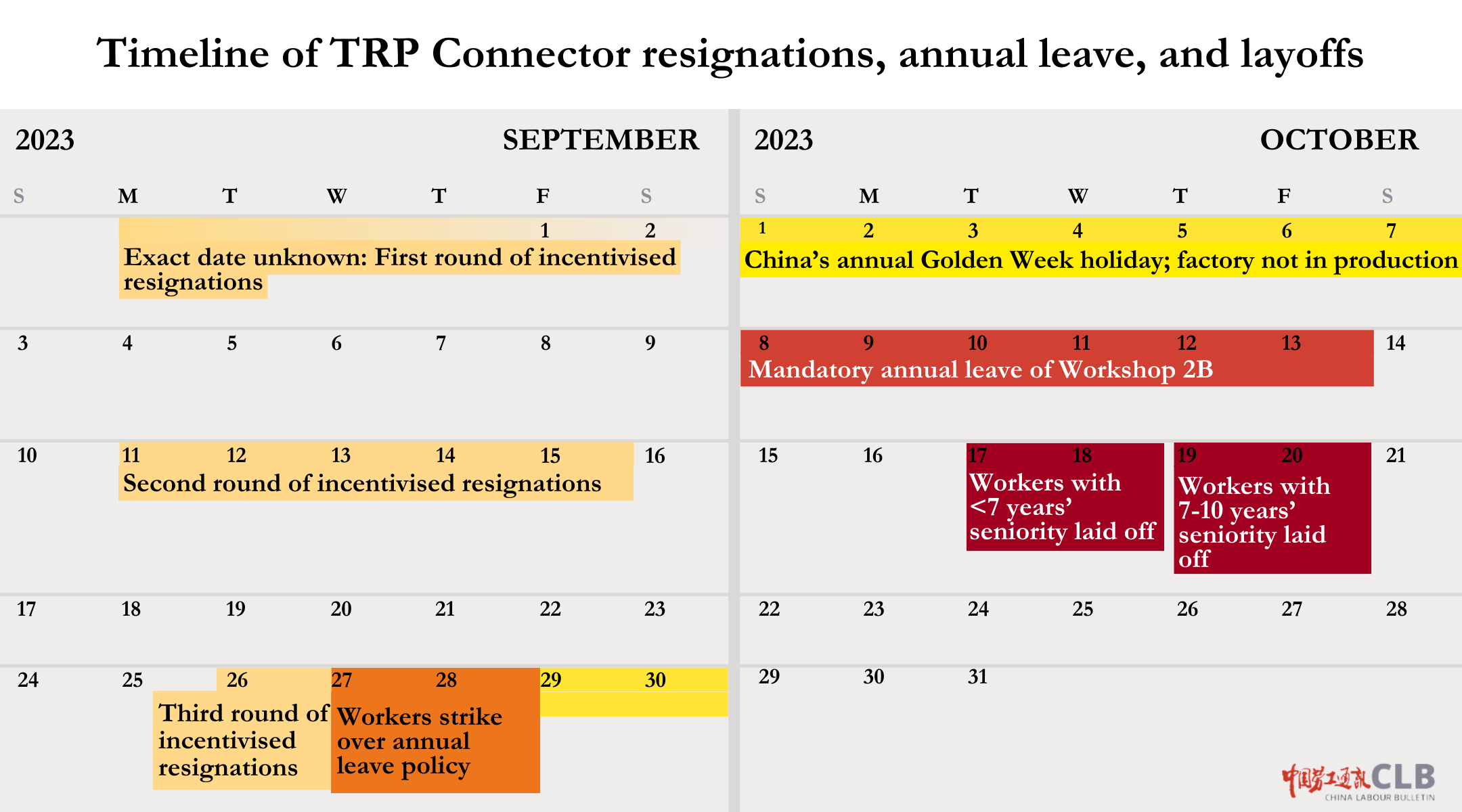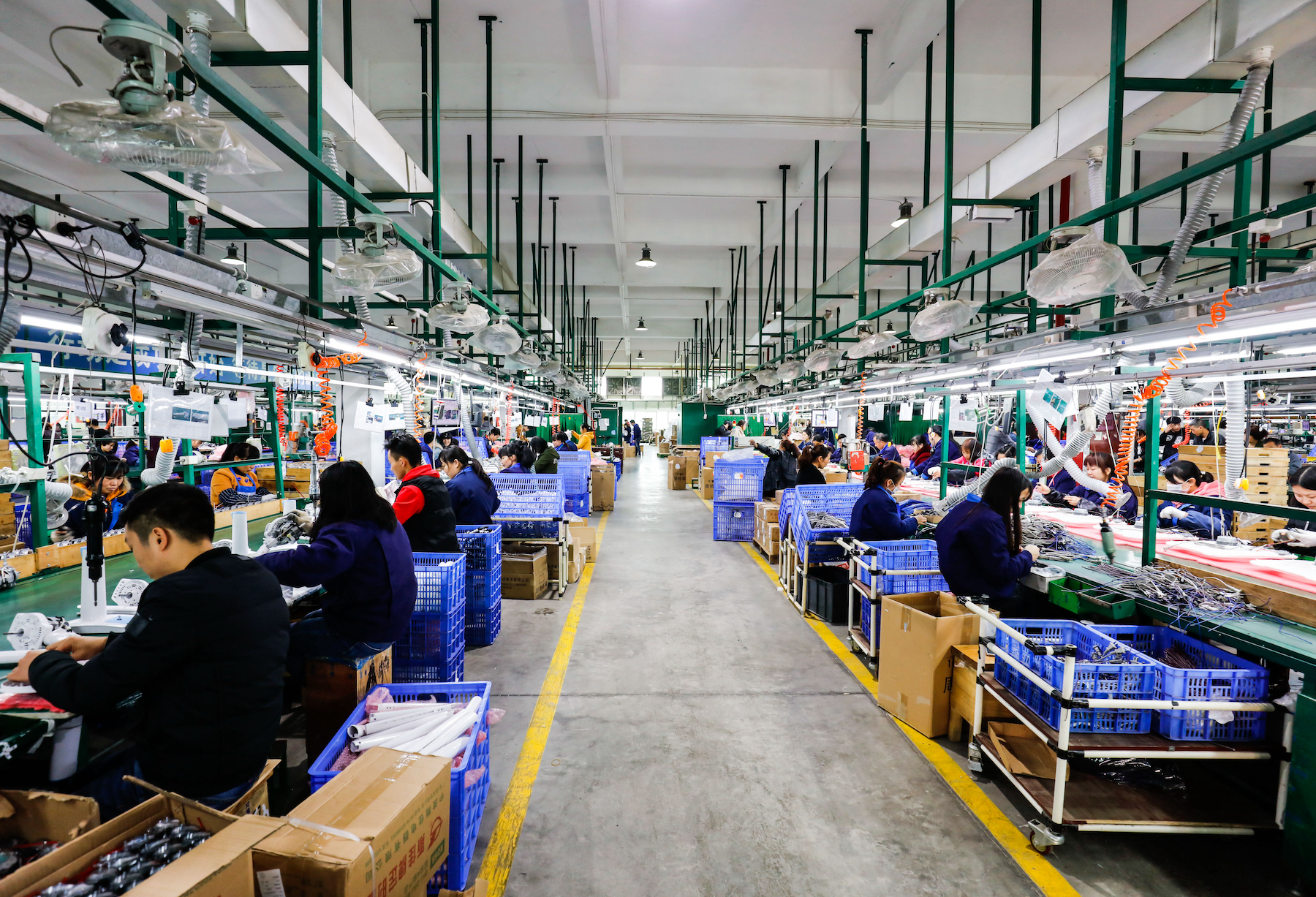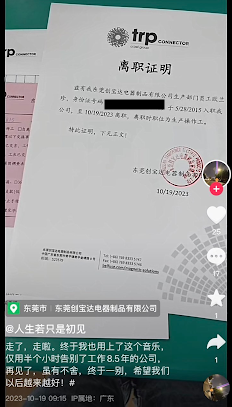Last month, China Labour Bulletin covered the case of workers at the Zhongshan Wing Ming Electric Co. Ltd. (中山市永明电子有限公司) protesting over reduced working hours and other vague indicators that they may be laid off sooner or later. In fact, the Wing Ming factory is part of a massive consolidation of Bel Fuse’s China operations, but this was not apparent to workers at the time.
Online discussion around why Wing Ming workers would be angry over more reasonable working hours pointed to the low minimum wage that leaves migrant workers vulnerable when the economy takes a downturn.
At another Bel Fuse factory in Dongguan, Guangdong province, workers at Dongguan Transpower Electric Products Co., Ltd. (TRP Connector) (东莞创宝达电器制品有限公司) went on strike on 27 September over a mandatory annual leave policy.
As recorded in the CLB Strike Map, the factory announced that workers in Workshop 2B must take six days of annual leave after the Golden Week holiday, meaning they were not working for 15 days straight, between 29 September and 13 October 2023. If workers did not have enough leave accrued, they were required to advance their 2024 leave. The factory attributed this policy to declining international orders.

A screenshot from the CLB Strike Map shows images and videos gathered from TRP Connector workers’ online posts related to the 27 September strike and subsequent layoffs
Together, these two cases at Wing Ming and TRP Connector show different tactics - some technically lawful and others blatant violations - that employers in China are using to avoid paying economic compensation owed to workers for employment termination.
As China’s manufacturing sector struggles in the post-Covid economy, thousands of workers’ rights and livelihoods are at stake. As shown in the Wing Ming and TRP Connector cases, workers are standing up to defend their rights, but power dynamics are not in their favour and workers need new solutions to ensure enforcement of their rights.
TRP Connector began formal layoffs in mid-October, but long-time employees still face uncertainty
TRP Connector produces integrated connector modules for U.S.-listed Bel Fuse. In 2013, Bel Fuse acquired TRP from TE Connectivity, a U.S. corporation domiciled in Switzerland that has substantial China operations. According to Bel Fuse’s 2022 annual report, nine Bel Fuse production sites in China will be consolidated by the end of 2023 into “a single centralized site” in Guangxi province, which it calls “the new Bel Guangxi facility.”
At its peak, TRP Connector employed around 10,000 workers, but only 1,435 were registered as receiving social insurance benefits as of most recent corporate records.
As of 17 October, TRP Connector workers with less than seven years’ seniority were being laid off. On 19 October, workers with between seven and ten years’ seniority were terminated.
These workers were reportedly given economic compensation that may be in line with legal minimums and allows them eligibility for unemployment insurance.
However, their average wage over the last twelve months - on which the legal minimum is calculated - is lower than in the past. Starting in February 2023, workers’ hours were reduced to eight hours per day, five days per week. This means that they were earning only minimum wage, as factory workers’ income comes largely from overtime, performance bonuses, and other types of compensation no longer available under reduced hours.
Surviving on only about 2,000 yuan (U.S. $273) per month in Dongguan is difficult. One worker who goes by the name Yi, has been working at TRP Connector for a decade. She makes short videos of herself dancing on the empty factory floor.

Worker Yi wears a TRP Connector uniform and performs a 15-second dance for the camera on the factory floor. Source: Douyin
When her hours were reduced in February, she posted online about seeking temporary work to supplement her income. She said that she finishes her eight-hour day at 3:30 pm, and her income from a 40-hour workweek was no longer enough to get by. She wrote:
It is so hard to face the difficulties at the beginning of the new year, we as workers are really suffering now.
In another video, she wrote:
[The factory] claimed it is not peak season now, so we are not paid to work on weekends. Can anyone introduce me to a temporary job? I can work hard and endure hardship. Please let me know if you need a temporary worker.
She ended up finding a job at another electronics factory, working four hours per day in addition to her eight hours at TRP Connector. Other workers said they also are working two jobs to make ends meet.
Now, eight months later, workers need to find new employment altogether. One TRP Connector worker posted a video online asking, “When will it be my turn [to get laid off]?” and other workers commented on their seniority and layoff status.
Some commenters wonder if TRP Connector workers will be relocating to Guangxi as part of the Bel Fuse consolidation plan, like Wing Ming workers also wondered. Others online asked if TRP Connector had already shut down, saying only: “Soon.”
Sweetening the deal for “voluntary resignations” in September
Just like for Wing Ming workers in Zhongshan, TRP Connector workers in Dongguan were in the dark about how the Bel Fuse consolidation plan would affect them. However, whereas at Wing Ming where the ambiguity and lower monthly income led some workers to seek other employment long before the factory ultimately shut down, workers at TRP Connector were more aggressively pushed to “voluntarily resign.”
Workers shared online a company notice offering compensation for resignations. Dated 11 September and titled as a “second call” for workers’ resignation, the company offered compensation to workers resigning between 12 and 15 September.
Those who had been employed less than one year would receive 2,000 yuan (U.S. $273), and those with over 10 years’ seniority at TRP Connector could receive up to 20,000 yuan. The offer did not extend to workers whose contracts would end within this year, and resigning workers are not eligible for unemployment benefits.

On 26 September, a third call for resignations was circulated. The terms were similar to the second call and extended to those resigning on or before 9 October.
In addition to a small amount of compensation for voluntarily resigning, TRP Connector facilitated resigning workers in finding new employment. In mid-September, for example, TRP Connector apparently struck an agreement with the nearby WKK factory (王氏港建科技), a Hong Kong-listed company manufacturing printed circuit boards (PCB). China’s PBC industry, concentrated in Shenzhen, is facing economic difficulties, too.
TRP Connector touted the benefits of working at WKK, saying that it is a large factory with good benefits, and offers overtime work, bonuses, and all required insurances.
Workers strike against mandatory leave policy of Workshop 2B
When workers learned of the mandatory leave arrangement at the end of September, they went on strike. On 27 September, Workshop 2B employees went on strike against the leave arrangement and were subsequently warned by factory management that “being absent from work” is against the company policy and workers would be disciplined.

Photograph: humphery / Shutterstock.com
Workers then sought help from the local labour bureau. The authorities responded to workers, stating that the company’s mandatory leave policy is unlawful. A worker left a comment summarising the department’s advice:
The labour department responds that the factory is not allowed to advance next year’s annual leave. For those who have leave available this year, the factory can deduct the leave. For those without remaining annual leave this year, the leave must be paid leave.
But even with this clear response from the labour department and the authorities’ knowledge of the unlawful leave arrangement at TRP Connector, workers were not able to leverage this against management for a change in their situation.
The company acknowledged the workers’ strike in a notice titled, “In response to the work stoppage at Workshop 2B”:
The company's overall arrangements for employees to take annual leave are in compliance with relevant laws and company regulations. If you have any questions, employees can also consult the Human Resources and Social Security Bureau.
Just as Wing Ming workers pleaded for more information - “When will the factory finally inform us? How long does the factory want to drag this out and not tell us the truth?” - TRP Connector workers are unclear whether they may be offered Bel Fuse jobs at the consolidated factory in Guangxi province or whether the voluntary resignation offer and work at WKK is their best option.
In either case, what is becoming clear is that the factory’s offer for voluntary resignation is an attempt to avoid paying the minimum legal requirements for economic compensation, as it is now doing for remaining workers with ten or fewer years of seniority.
One worker wrote online before the layoffs began:
Does the boss think that rank-and-file workers will more easily accept a bad fate, or that we are easy to deceive? They always ask workers to think from the side of the boss, but are the bosses also thinking from the side of workers? If we all have in mind the same thing [laying off workers], why make it so complicated and annoyingly awkward?
Another worker wrote:
Who can tell me what we workers should do? We will not get unemployment insurance if we resign voluntarily, and it is so hard to survive here. [Crying emoji]
Without clarity on the factory’s plan, workers have not had adequate information to make decisions in their best interests, leaving them vulnerable to exploitation even if the factory did not technically violate China’s labour laws in urging “voluntary resignations.”
Workers deserve adequate and timely information on company plans that affect their wages, working conditions, and employment status
China Labour Bulletin notes that TRP Connector indicated to striking workers that their “absence” is against company policy. But Bel Fuse’s human rights code guarantees workers in its supply chain the right to freedom of association.
The situation for TRP Connector workers is ongoing, with some already resigning and taking the offered compensation, others waiting it out and receiving unilateral termination with compensation this week, and others still waiting for their fate to be determined.

In a now-deleted video, a worker with eight and a half years’ seniority at TRP Connector posted that they were laid off on 19 October. They wrote in the video description, “I’m leaving… It only took half an hour to say goodbye to this company where I’ve worked for 8.5 years. Even though I’m reluctant to part, finally I’m leaving. I hope that in the future things will get better for us.” Source: Douyin
Some workers have gotten a relatively fair deal. But for those still waiting, they can only hope to be treated similarly. Workers are left at the mercy and whims of the factory after sticking it out through the pandemic and more recently facing reduced hours and wages for more than half a year.
Treating workers with dignity involves providing them with information relevant to their employment status in a timely manner, so that workers can decide for themselves whether to stay or go and under what terms.
Fulfilling this basic requirement could involve the enterprise union or local union as an intermediary representing workers. It would be in the interest of multiple stakeholders to involve factory suppliers and Bel Fuse in these conversations to ensure that Bel Fuse’s human rights commitments are upheld during the company’s consolidation plan.
Further CLB reading:
- "We will finally do something brave": Zhongshan electronics factory workers protest over uncertain fate (September 2023)
- After China’s Golden Week holiday, will workers return to find closed factories? (September 2023)
- Surge of manufacturing protests in China deserves international attention (May 2023)
